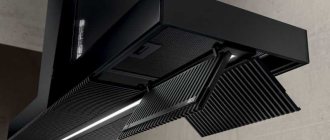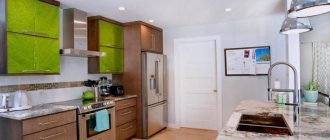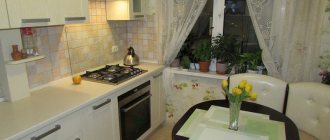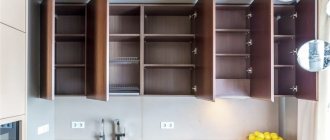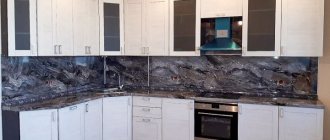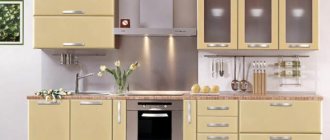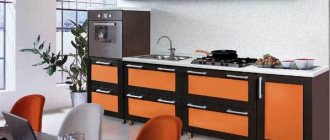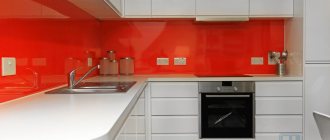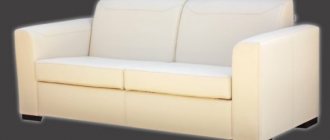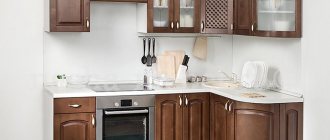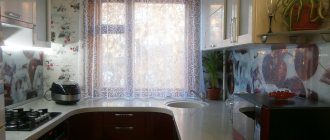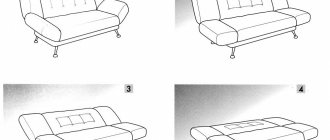Types of acrylic facades: nuances of production and comparison with other materials
Acrylic facades vary depending on production technology. The filling or base can be MDF or chipboard. But not only the appearance, but also the performance characteristics will depend on the method of applying the protective finishing coating.
Depending on the production technology, there are the following types:
- With acrylic film (acryline) , which is formed on a base made of chipboard or MDF after attaching paper impregnated with polymethacrylate resin to a special glue and pressing under high temperature. During this process, the finishing coating is transformed into a thin and durable film, which is superior to simple PVC film in many performance characteristics.
- Solid acrylic panels (with acrylic glass) . They are obtained by applying pure acrylic to a base and further irradiating it with ultraviolet light. The polymerization process produces so-called acrylic glass, which is a more durable coating that is 100% resistant to fading.
Which option should you choose? In the table below we have provided a comparison based on several parameters. What is your priority (price, super strength, design) is, of course, up to you to decide.
| Comparison options | Acrylic film | Acrylic glass |
| Price | Cheaper | Expensive |
| Mechanical strength | Less | Higher |
| Lifetime | Smaller than acrylic glass Up to 10-15 years | Higher than acrylic film Up to 30 years old |
| Design options | Can be made bent, radius | Only rectangular, straight |
| Risk of material peeling | Minimum | Deleted |
| Possibility of sealing edges using postforming method | Eat | No |
Watch also a video from an expert about a comparison of acrylic facades, their advantages and disadvantages:
Acrylic cladding can be one-sided or two-sided. The second option is preferable for color options.
Special attention should be paid to the finishing of the ends. The facade must be protected on all sides with plastic, acrylic or PVC edges. Postforming, when the edges have a slightly rounded appearance, is considered a more reliable method of facing the ends. This option better protects the product from moisture penetration.
With laser edge
Before purchasing a kitchen, visually evaluate the quality of the edge application. The best option is one in which the edge fits tightly at the ends, and the furniture seam at the joints is almost invisible.
There are no frame options among acrylic facades. For display cabinets, the frame structure is made of aluminum. This will affect the cost of the kitchen set towards its increase.
How acrylic facades are made
The acrylic facade can be compared to a sandwich, as it is a multi-layer product. The base uses an MDF board with a thickness of 16-18 millimeters, a layer of acrylic from 1 to 4 millimeters on top, and a layer of melamine on the bottom. In more expensive options, a layer of acrylic is applied not only to the outside, but also to the inside.
Since acrylic or acrylic glass itself has no color, the issue of shade is resolved at the production stage by adding dye to the raw material itself. And options with drawings and complex color schemes are carried out at the stage of preparing the base - MDF boards. Ultraviolet irradiation allows all layers to be firmly bonded without further delamination.
When using film, the process is slightly different. After applying it, the sandwich is placed in a special press and heated. As a result, the film and the plate become one.
The cooled panels are cut to the required sizes and the ends are sealed.
Requirements for the base for acrylic coating
You need to figure out why expensive MDF is used as a base when it can be replaced with cheaper chipboard. The latter is not durable and has not proven itself to be reliable in operation. Therefore, today MDF is the optimal option.
Pros and cons of acrylic coating
Advantages:
- impact resistance;
- scratch resistance;
- resistance to steam and moisture;
- high aesthetics, especially in glossy, pearlescent finishes;
- rich and deep color rendering;
- wide palette of shades;
- resistance to dyes and chemicals;
- resistance to fading under the influence of ultraviolet radiation;
- ease of care;
- environmental Safety.
Please note that the indicated advantages, all other things being equal, have facades from a reliable manufacturer. Therefore, when choosing, pay attention to the quality of workmanship and the quality of edge application. If there is a display sample in the store, ask the seller to test you for wear resistance and scratch resistance.
Flaws:
- it is impossible to make a textured, relief surface;
- there is no possibility of manufacturing kitchen doors with milling or panels;
- The glossy façade is of low quality and is easily scratched. But unlike the same film, it can be restored: shallow scratches can be sanded up to 3-4 times, and the surface will be like new again.
You can do the polishing yourself by purchasing a special product at a furniture store - polish. Before purchasing, it is important to make sure that the product is intended specifically for acrylic surfaces.
The facade is the face of your kitchen. Plastic and Acrylic
The facade is the face of your kitchen. With kitchens it’s almost the same as with people: as many people there are, so many faces, and kitchens each have their own façade. Only the fronts will give your kitchen personality. In order for you to be able to buy Belarusian ZOV kitchens, our company has created its own production of furniture facades made of plastic and acrylic.
Facades made of plastic. When making plastic facades, a chipboard board is fused with a plastic sheet using a special composite adhesive. To produce such facades, ZOV-LenEVROMEBEL JLLC uses special laminated paper from such proven world leaders as FORMICA (Finland) and EGGER (Austria). When it is created under conditions of high temperature and pressure using a press, certain types of paper are spliced, treated with a special absorbent impregnation. The thickness of such plastic varies from 0.3 – 2 mm and above. In the case of such plastics, their finishing layer has a glossy, matte or structured surface that follows the textures of various materials: from stone to wood. The color palette of plastics is also extremely diverse. This variety, combined with high performance qualities (resistance to temperature changes, low susceptibility to various detergents, mechanical wear, as well as solar radiation) and reasonable price, makes plastic one of the most popular materials for the production of kitchen facades today. Plastic is also perfect for making radius facades, such as those used in one of the most fashionable collections of 2015 - ORION.
Acrylic facades. Perhaps acrylic can be considered one of the most modern and high-tech materials, which is used for the production of kitchen facades in today's realities. In such facades special ABC edges are used. In this regard, the process of coating MDF with acrylic plastic is quite complex and requires special equipment and well-prepared production so that your acrylic facades can delight you with their stunning gloss for a long time. You should immediately warn the potential buyer of an acrylic kitchen that it is the high gloss of acrylic kitchens that is at the same time their main pitfall, since noticeable fingerprints remain on it. However, this drawback is offset against the background of other advantages of acrylic facades, such as: environmental friendliness, resistance to UV radiation and color loss, to mechanical stress, as well as to water and steam. The main thing is to treat the acrylic facades of your ZOV kitchen during initial use with a special kit for the care of acrylic facades. The treatment will give them additional resistance to dirt, dust and damage. Unlike other manufacturers, the group has technologies that allow it to produce kitchens with radius acrylic facades. In particular, radius acrylic facades are used in the new ORION collection
Acrylic facades are widely used in combination with built-in Shuko handles in the new product for 2015 – the “INTEGRO” collection.
Source: zov.by
Which is better: plastic, acrylic or enamel?
The quality of any material is best known by comparison. Acrylic is often compared to enamel, PVC film and HPL plastic. We compared all three options and selected a winner using a point system.
For each comparison parameter, all options were assigned from 0 to 3 points, where 3 is the highest score, 2 is average, 1 is low, 0 is the absence of a particular property.
| Comparison options | Plastic | PVC film | Enamel | Acrylic |
| Affordable price | 3 | 3 | 1 | 2 |
| Impact resistance | 2 | 1 | 1 | 3 |
| Moisture resistance | 2 | 1 | 3 | 3 |
| Scratch resistance | 1 | 1 | 2 | 2 |
| Variety of colors | 3 | 3 | 3 | 3 |
| Possibility of producing bent and radius | 0 | 3 | 3 | 2* *only with acrylic film |
| Possibility of simulating wood, stone, concrete and textured surfaces | 3 | 3 | 0 | 0 |
| Heat resistance | 1 | 1 | 3 | 3 |
| Resistant to fading | 1 | 1 | 3 | 3 |
| Environmental friendliness | 1 | 1 | 3 | 3 |
| Easy to care for | 2 | 1 | 3 | 2 |
| Possibility of restoration | 0 | 0 | 3 | 3 |
| Result: | 19 | 19 | 28 | 27 |
From the table above we can conclude that, all other things being equal, facades with enamel are slightly superior to acrylic ones in some characteristics, namely, they have more design options, can be of any shape, with panels and milling, suitable for both classic and modern interiors. However, their cost is higher compared to acrylic ones, and plus they are inferior to them in impact resistance and scratch resistance.
We can absolutely say that acrylic facades are significantly superior to their analogues made of plastic and PVC film in many respects.
Kitchens "Maria". Headset model - “Vector”
German facades Rehau
See also a useful video from an expert in the field of kitchen furniture, in which plastic and acrylic facades are compared:
Acrylic kitchens - ideal value for money
Plus, in addition to all its advantages, the price of acrylic facades is less than other types: for example, solid wood, veneer, MDF with enamel coating. Natural wood is always in price because of its presentability and uniqueness. But acrylic has a lot of other advantages that wood does not have: for example, resistance to changes in temperature and moisture, and ultraviolet radiation. Acrylic facades with an MDF base are more expensive only than thermoplastic, which is inferior to it in terms of quality characteristics. But compared to enamel, acrylic is more wear-resistant, but costs less. If you choose acrylic film rather than panels, you will get an economy class kitchen for the price.
On our website “Kitchens Biograph” prices for acrylic kitchens range from 32,400 to 38,800 rubles per linear meter (price may vary). For comparison: kitchens made of solid ash - from 40,300 rubles. per m.p.; kitchens coated with Italian enamel - from RUB 35,600. per m.p.; made of thermoplastic - from RUB 26,500. per m.p.
Matte or glossy?
The choice between matte and glossy facades is not only a matter of taste, but also expediency. It is believed that glossy shine visually expands the space due to the reflection of light. This is true, provided that the facades are light shades (white, cream, mother-of-pearl, light gray).
However, you need to be careful here if the kitchen windows face south and the room gets very bright sun most of the day. Gloss will further enhance this effect.
Saturated, deep colors will look better in a matte finish. For example, bright orange or bright green in themselves attract attention in the interior, but in combination with gloss there is a risk of overdoing it. In addition, the zest of complex tones obtained by mixing different colors can be lost under gloss, since gloss often distorts the shade.
As for care, we rightly note that both get dirty equally. However, it is easier to care for glossy ones, since it is easier to remove dirt from a smooth, even surface.
Properly selected handles that minimize contact with the surface of doors and drawers will help keep your kitchen clean longer.
Competent care
You need to know simple rules for using glossy facades, in addition to wiping them daily. If the contamination is minor, then you can get by with soapy water and a soft cloth for daily care. On days when the acrylic kitchen is not in use, there is no need to wipe the furniture, since the perfectly flat surface does not trap even particles of dust.
Manufacturers guarantee long-lasting facades, acrylic on which is one of the materials that can withstand fairly intense impacts. If a small defect does appear, then it is enough to level this area with sandpaper and then polish it.
After its final installation, the protective film that protected it during storage and transportation is removed from new furniture. Opened to external influences, modern acrylic facades must adapt to the atmosphere of the kitchen. Of particular importance is the fact that when exposed to high humidity, acrylic becomes harder. If no additional steps are taken, the process of adapting an acrylic kitchen takes almost 70 hours.
Experts recommend immediately wiping new acrylic facades with a soft cloth soaked in a low concentration soap solution.
There are special products without an alcohol component and without harsh abrasives that create conditions for acrylic to harden and prevent stains or scratches from appearing.
Color scheme and decor
Since acrylic itself is a transparent material, the dye is added at the production stage. The desired pigment enters the resin or decorative layer before pressing or polymerization. The production process itself gives a certain advantage to acrylic facades: rich and deep color and a high degree of gloss.
Mother-of-pearl shades look especially beautiful.
There are practically no restrictions on the color scheme. You can get any shade and apply any print using photo printing.
Acrylic facades for the kitchen: quality and beauty at an affordable price
In the constant struggle for buyers, kitchen set manufacturers try to pay attention to the appearance of their products and improve their performance characteristics. In addition to the use of high-quality fittings and the use of durable, moisture-resistant materials for the manufacture of facades, much attention is paid to the choice of coatings. The appearance of kitchen furniture, durability, resistance to damage and temperature changes depends on the material used to cover the facade.
Facades should always look great
Acrylic facades appeared on the market not so long ago, but have already gained popularity among consumers. Acrylic facades combine excellent design, affordable price, high consumer qualities and have found application not only in the mass production of kitchen furniture, but also in the manufacture of sets based on individual projects.
Stylistic decisions
Since acrylic facades are only possible in a smooth design, without panels, milling and other decorations, they cannot be used in the design of classic, rustic and traditional kitchens, as well as kitchens in the Provence style. But for modern trends, modernity, they will be the ideal solution.
Light glossy kitchens will be an excellent solution for a kitchen in a high-tech or minimalist style.
Bright, acidic shades will fit perfectly into a pop art style interior.
Dark glossy facades will be appropriate in an art deco interior, as they add that very glamor that is the hallmark of this style.
Kitchen "Vector" from the factory "Maria". Designer Ignatieva Angelina
Photos of kitchen sets with acrylic facades
<
>
Thus, acrylic kitchen facades are a highly functional, stylish and durable option for organizing the interior of a room. Their glossy surfaces will add more light and depth to the space and will fit perfectly into any modern design.
Top 6 manufacturers
- Adelkreis is a company that has adapted production technologies for furniture from the German automobile industry. Particular attention is paid to the production of facades. The first patented collection of high-gloss facades “Brilliantlinie” with 1.5 mm thick acrylic glass was released back in 2013. Seamless processing of seams using the postforming method ensures high reliability of the product.
- Senosan , a company that is part of the Austrian concern Klepsch, has been operating since 2011 and specializes in the production of super-durable polymer films.
- Tefri is a Russian company with production in St. Petersburg, operating since 2021, and is a large supplier of furniture components throughout Russia. Tefri is one of the few domestic companies that uses the laser method of applying edges (considered the most reliable and aesthetically pleasing). They provide a guarantee for their products.
- Rehau – German-made facades are produced under this brand. Seamless edge joining technology is used in production. The cost of Rehau products is an order of magnitude higher than that of previous manufacturers, but at the same time it is distinguished by its aesthetics and high quality.
- Akrylite – furniture components made in Italy. The facades of this brand are produced by the international company, which has been present on the market since 2006. It supplies acrylic panels at affordable prices, but the choice of colors is not as diverse as compared to the companies mentioned above.
- Sidak is one of the most popular suppliers of furniture facades in Russia. Has been working for more than 20 years. The production is located in the Leningrad region.
Types of glossy coatings and care features
Before you start washing facades, you need to find out what material they are made of.
Glossy coating is made from various raw materials:
The acrylic coating is applied to the MDF surface using polyurethane glue, resulting in a rich glossy shine. Although the material is expensive, it is easy to care for and always looks elegant. It is quite easy to remove dirt from it, and any damage that occurs can be polished. At the same time, acrylic enamel is not resistant to mechanical damage and aggressive chemical components.
Unlike elite acrylic, plastic is a budget option. Kitchen cabinet fronts are made from cheaper chipboard, onto which a laminated paper sheet of plastic is glued. This is done using the postforming method: under high pressure and at high temperature.
The plastic coating is resistant to damage and any non-aggressive detergents, but if defects and scratches appear on the surface, it becomes impossible to remove them. The plastic facade has the main advantage of being 100% waterproof, so it can be washed without fear of deformation. This gloss is highly durable and has a long service life.
Low-quality glossy plastic is prone to rapid loss of color brightness, which should be taken into account when using detergents.
On painted MDF facades, the glossy effect is achieved using several layers of varnish. They can be called high-quality only if the production technology is followed, from sanding and priming the surface to thoroughly sanding and drying each layer of varnish separately.
Compared to plastic, the gloss of painted facades can, if necessary, correct minor defects or make them less noticeable. The doors of the set, coated with varnish, do not need to be hidden from direct sunlight, although their color may change slightly if exposed to the sun for a long time. This gloss is not afraid of moisture and temperature changes, so it does not deform upon contact with liquid .
If the varnished gloss is mechanically damaged, there is a high probability of paint chipping.
Glossy PVC film is applied exclusively to MDF facades using the hot vacuum pressing method. Along with kitchens with plastic facades, such products belong to budget category furniture. The surface of the film is resistant to discoloration and abrasion, but it is better not to expose it to direct sunlight.
wash PVC gloss with household detergents that do not contain abrasive components. If you are not sure of the quality of workmanship, you should not use a wet sponge for cleaning. If moisture constantly gets on a poorly pressed surface, the film will begin to peel off after some time.
Acrylic panels for splashback
Acrylic panels can be used not only in the production of kitchen facades, but are also widely used in finishing aprons. All their positive qualities, which we wrote about at the very beginning of the article, namely heat resistance, moisture resistance, resistance to fading, mechanical strength, ease of maintenance, allow the use of this material to protect the work area.
With such an apron you can make a solid, monolithic, seamless coating, apply any design or pattern, and recreate any shade.
How can you wash and clean the glossy surface of a kitchen set?
If you have become the happy owner of a glossy kitchen set, then you are in luck: the furniture not only pleases the eye, but also visually expands the room and gives a feeling of spaciousness.
This is a real find for a small kitchen. Thanks to the ability of gloss to reflect light, the walls seem to move apart and the ceiling becomes higher. Of course, you will want your furniture to always shine like new. This raises the question: how to wash a glossy kitchen set so that it retains its pristine beauty? We'll talk about this in the article.
Secrets of care
Glossy kitchens are difficult to maintain. However, like matte ones. After all, dirt and fingerprints are equally noticeable on both versions. The only difference is that the gloss must be maintained: special care products will be required, and there will be certain restrictions on the use of certain detergents. Matte ones are easier in this regard.
What should never be used in caring for acrylic facades?
- Abrasive detergents. They contain small coarse particles that will scratch the surface of the kitchen. The gloss will quickly fade after such exposure.
- Alcohol-containing substances. They also negatively affect the gloss and destroy its shine over time.
- Hard brushes and sponges, steel wool.
- Furniture waxes.
- Products containing acetone and nitroglycerin.
Now let’s talk about how to clean them correctly:
- Wash the surface with a mild soap solution and a soft microfiber cloth.
- Polish the facades regularly using a special product. This will get rid of minor scratches and restore their shine.
- You can use special products for treating acrylic surfaces, glass cleaners that do not contain alcohol, and sprays for glossy surfaces.
Acrylic facades are pleasing because they have a flat, smooth surface without milling, relief or other decorative elements. This already makes it easier to care for.
The most impractical option is a glossy black kitchen. They, of course, look authentic in glamorous interiors such as art deco, but are completely unbearable to maintain. The slightest splashes of water and stains will be noticeable. If you cook often and a lot, you are unlikely to appreciate the need to wipe the surface of the facades just as often and a lot.
What is acrylic
Among several varieties of polymers, acrylic should be highlighted, which is successfully used in facade systems. Acrylic was used as a facing material for kitchen facades in Italy and immediately attracted the attention of leading furniture manufacturers.
It turned out that the bright and durable material had been known for quite a long time, but had not yet been used in this capacity. Acrylic is obtained by polymerization, it is transparent and thermoplastic. Another name for the material is polymethacrylate. Available in sheets of various sizes.
Characteristic properties and some features
Acrylic has a number of properties that have made it a popular material and a serious competitor among other plastics used in the manufacture of facades.
Among the main beneficial properties of acrylic, the following are worth highlighting:
- high mechanical strength. This characteristic gives the acrylic coating resistance to mechanical damage (scratches, chips);
- UV resistance. This means that the facade will not fade in the sun and the kitchen will retain its spectacular appearance for many years;
- acrylic is not affected by water. One of the main indicators of high-quality material for furniture facades, taking into account the special conditions in the kitchen;
- has an absolutely smooth and even surface. Thanks to this, acrylic facades are easy to care for;
- Only environmentally friendly components are used in the production of acrylic. Due to this, during processing and in finished form, such facades do not emit any toxic substances into the atmosphere.
Despite the impressive useful characteristics, acrylic facades have a number of features. They cannot be considered shortcomings of the material; they should simply be taken into account when choosing a kitchen set.
- acrylic facades are always flat. This is due to the fact that acrylic cannot be bent without destroying it, therefore it is physically impossible to make a semicircular facade or create a relief surface;
- Facades with acrylic coating are never of the display type, that is, with glass. This is also due to the technical properties of the material and production features;
- an acrylic furniture façade will always have a regular geometric shape (most often rectangular) with a monolithic, smooth, even surface.
Acrylic facade design
Acrylic is a facing material that is fixed to a specific base. The basis of the facade is two materials - MDF and chipboard. Each of them has its own characteristics, but the main difference will be that the chipboard facade will be more massive and thicker than MDF. The edges of the resulting facade are trimmed with acrylic strips or covered with an aluminum frame. This option is considered the most reliable, and additionally gives an aesthetic appearance to a modern kitchen.
There are two main types of facades according to the method of covering them with acrylic:
- one-sided option. In this case, acrylic is applied to the front surface, and the back is white. Most often MDF is taken as a basis;
- two-way method. In this case, the base material does not matter, and acrylic covers the facade on both sides. The facade looks much richer, but its cost doubles. It is recommended to use double-sided fronts for lower cabinets with hinged doors and for all upper wall cabinets.
Comparison of acrylic with the most common facade materials
All the materials used for the manufacture of facades can be listed for quite a long time; it is worth dwelling only on the most common ones:
- MDF with various cladding options (film, enamel, plastic);
- natural wood;
- laminated chipboard.
Each of the options under consideration has its own characteristics and unique properties that are superior to acrylic or inferior to it.
Main types of MDF facades
MDF is a high-tech material that is used as the main material in the manufacture of facades. MDF has three main facing materials:
- PVC film;
- enamel;
- plastic (including acrylic).
Film facades have a number of characteristic advantages:
- low cost;
- wide color surface and the ability to imitate natural wood species;
- the possibility of producing embossed or radially rounded facades.
In addition to their advantages, films have a number of features:
- possible peeling of the film from the base when the temperature rises;
- they become discolored over time when exposed to sunlight;
- have low resistance to mechanical damage;
- When cleaning, it is important to use detergents with a chemically neutral composition.
Enameled facades are produced in several stages. First, the workpiece is sanded until it has a completely smooth surface, then it is primed and enamel is applied. Then they are opened with varnish and polished if necessary.
The most significant advantages of painted facades:
- have high mechanical strength;
- the ability to add absolutely any color or shade, including applying the author’s exclusive decor to the surface;
- practically not subject to fading in the sun;
- In case of damage to the enamel layer, the facade can be tinted yourself, and, if desired, repainted in any color again.
In addition to an impressive list of advantages, enamel has a number of disadvantages:
- such facades are considered the most expensive and are comparable in cost to natural wooden models.
- require constant care due to the visibility of fingerprints and other small dirt.
Plastic facades, including acrylic coating, are manufactured in various ways, but have some common properties:
- high mechanical strength. The plastic is practically not susceptible to scratches (unless you deliberately pick at it with sharp objects) and successfully resists impacts.
- most plastics do not fade in the sun;
- the outer plastic coating does not react with water and most alkaline solutions;
- a fairly large range of colors and shades, which is second only to enameled facades;
- relatively low cost.
The disadvantages of plastic include the same fingerprints and some features in care (for example, you should not use abrasives).
Advantages and disadvantages of MDF facades with acrylic cladding
Acrylic coating has a number of unique properties:
- it is durable and not subject to scratches, deformations and chips;
- resistant to sudden temperature changes;
- has maximum glossy effect. There is a universal indicator for measuring the level of gloss - gloss. For a normal shiny surface its value is 60 units, the maximum achieved for other materials is 70 units. For acrylic, this figure is 80;
- acrylic is more durable than any of the similar polymers;
- has maximum environmental friendliness. During production and operation, no resins or carcinogens are released. In addition, acrylic is the only one among similar materials that is completely recyclable.
Despite its high technological and aesthetic performance, acrylic coating has some disadvantages:
- thanks to the high level of gloss, any minor contamination is clearly visible on the surface - traces of water splashes, fingerprints and dust;
- Oversaturation of the room with glossy surfaces can irritate the eyes when exposed to sunlight repeatedly.
Not everyone can feel comfortable for a long time in a kitchen that has a lot of glare.
Reviews from real customers
An objective picture of the operation of acrylic facades will be supplemented by reviews from real customers.
The reviews below were taken from independent forums on the Internet. We also emphasize that reviews do not provide a 100% guarantee of reliability, since the quality of furniture will depend not only on the material itself, but also on other factors: manufacturer, production technology, operating conditions, etc.
Acrylic kitchens: customer reviews
Almost all acrylic kitchens look wonderful in the photo, but what will real buyers say? Most reviews confirm that the pros of acrylic kitchens outweigh the cons. Here are some reviews from Russians about this fashionable furniture:
“We’ve been wondering for a long time: acrylic or enamel for the kitchen - which is better? We looked through hundreds of photos and visited showrooms. In the end, we settled on acrylic and did not regret it. The furniture is not only nice to look at, but also quite comfortable and durable. We cook daily. The facades adequately withstand all executions such as splashes of water and hot oil” (Oksana and Nikolai Antoshchak).
“I was afraid that the acrylic facades would need to be constantly wiped down. The consultant advised to choose light ones. And indeed, the “fingers” on them are almost invisible, I clean them once or twice a week” (Natalia Chemeris).
“I installed the kitchen 5 years ago, glossy, champagne color. So far no complaints, except for a minor scratch. The cabinet next to the window in direct sunlight has not faded at all. Overall, I’m satisfied” (Viktor Spassky).
Photo gallery
The main secret from furniture makers for caring for acrylic facades
- Each facade is covered with a special film that protects furniture from scratches during transportation and preparation of furniture blanks. This film must be removed only after installing the furniture, and you can wipe the facade a day after you remove the film from the facade. After you remove the protective film from the furniture, its surface becomes extremely susceptible to the external sources surrounding it. After removing the film, the surface of the product must gain the strength necessary to enhance its properties. The process of acquiring strength can take up to three days. If you want the facade to harden faster, the surface of the facade needs to be moistened with a soft cloth and soapy water 1% solution. Before wiping, the napkin must be wrung out until damp.
- To increase the durability of your facade and increase its resistance to scratches, wipe it with a polishing agent.
- Treat the surface of your furniture with antistatic agents to relieve static load.
- It is not allowed to clean the glossy façade with wax-containing products or steaming methods.
Take care of your furniture, and it will repay you with a long service life and will delight you with its appearance for many years!
If you have questions about the manufacture of facades or have additional questions
contact our managers. We will be happy to provide you with all the information on the characteristics and availability of glossy panels.
Source
Problem #2. The glossy surface of the furniture has yellowed or faded
Unfortunately, over time, the glossy finish may lose its original color and acquire a yellowish or greenish tint. This usually happens in places exposed to sunlight, and only with cheap facades coated with polyurethane varnishes or PVC films of suspicious quality. Acrylic coatings are more expensive, but they are more UV resistant and will not yellow over time.
p, blockquote 27,0,0,0,0 —>
Painted MDF facades can also turn yellow over time - if they were coated with alkyd-based paints.
p, blockquote 28,0,0,0,0 —>
At first, the color of this set was the same as that of the refrigerator.
It is no longer possible to restore the original color using household chemicals. One of the ways to return facades to their “former greatness” is by sanding and painting with high-quality enamel or pasting with a good film (not Chinese). But finding a contractor who will agree to carry out such a restoration will be quite difficult.
p, blockquote 29,0,0,0,0 —>
An easier option is to completely replace the doors. In this case, based on past mistakes, you can choose a glossy acrylic, plastic or wooden kitchen.
p, blockquote 30,0,0,0,0 —>
If the yellowness appears as a result of many years of exposure to grease and soot on the furniture, then you can try to clean it:
p, blockquote 31,0,0,0,0 —>
- Mix vinegar or wood cleaner with water in a 1:1 ratio and pour the resulting solution into a spray bottle.
- Spray in some inconspicuous place, wipe several times in a circular motion with a soft sponge, after wearing rubber gloves. After making sure that everything is fine with the surface, wipe all yellowed areas.
- Rinse the sponge thoroughly with clean water and rinse the solution from the facades.
- Wipe everything with a soft, dry cloth.
p, blockquote 32,0,0,0,0 —>
If this method does not help, you can try a special paste for washing furniture and bathroom fixtures in the kitchen. Also apply a little to an inconspicuous area first to make sure it is safe.
p, blockquote 33,0,0,0,0 —>
Problem No. 3. Scratches appeared
If the scratch is small, try the good old remedy - sunflower oil. Try soaking a cotton pad in it and wiping the surfaces.
p, blockquote 34,0,0,0,0 —>
p, blockquote 35,0,0,0,0 —>
If the chip is of “moderate severity” but does not reach the wood, you can use:
p, blockquote 36,1,0,0,0 —>
- Wax polish. Rub it thoroughly over the damaged area until it becomes smooth.
- Special spray varnish for door repair (halo-free, based on one-component acrylic). It can be purchased from door manufacturers or sellers - you are unlikely to find it in a regular repair store. The rules for its use are described on the label of the can.
In case of serious damage to varnished veneer, there is also a good solution:
p, blockquote 37,0,0,0,0 —>
- Pick up a hard wax pencil that matches the color of your facades at a hardware store (in the door or laminate department).
- Melt the pencil (or simply knead the wax with your fingers) and rub the dent until the wax completely fills it.
- Wait until the wax hardens, and then carefully remove any excess wax with a spatula or blade (not a rag!).
- Sand the area using a sander or 400-grit sandpaper.
- Cover the surface with a non-halo repair varnish (the usual one will not work, it will crumble quickly).
These instructions are also suitable for film facades. The most difficult thing is to choose the right color. If the film imitates wood, then you can use a set of markers for laminate flooring. In this case, there is a 100% chance of hitting the color.
p, blockquote 38,0,0,0,0 —>
p, blockquote 39,0,0,0,0 —>
Tip: before going to the “heavy artillery” and rubbing the varnish with various polishes and waxes, try to carefully cover the chip using a thin artist’s brush and matte varnish. Perhaps the result at this stage will satisfy you.
If the scratch is so deep that the wood is touched, then before applying wax we clean the edge, mix the stain with alcohol or solvent and tint the damaged area. Then do steps 1–4 above.
p, blockquote 41,0,0,0,0 —>
If the facades of your set are made of glossy plastic, then it is almost impossible to correct its flaws. Most likely, the plastic will have to be re-glued.
p, blockquote 42,0,0,0,0 —>
